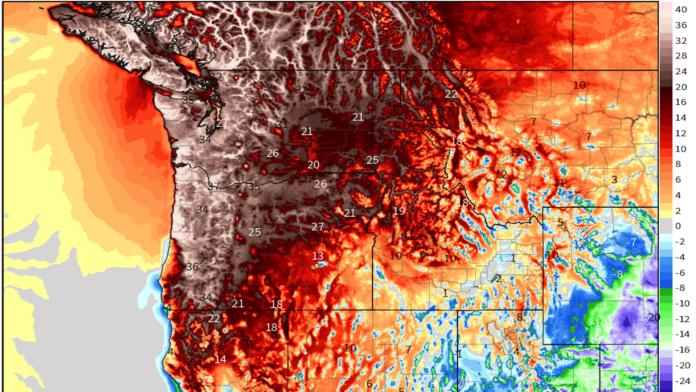There is no doubt in the vast majority of minds of those in media outlets across North America that the last few weeks have demonstrated that global warming isn’t just coming, but already here.
It doesn’t matter whether you live in Las Vegas or Lytton, because early summer temperatures in both locales have been approximately the same. It makes sense that daytime temperatures exceed 45 Celsius (113 Fahrenheit) in Las Vegas, smack in the middle of the desert in the U.S. Southwest. But Lytton, British Columbia, is well north of the 49th parallel, in fact, more than halfway to the North Pole. Such temperatures at this latitude are unheard of. On one day this small Canadian village saw thermometers rise to 49.6 Celsius (121.3 Fahrenheit). A few days later a wildfire burned the village to the ground with the fires ignited by pyrocumulus clouds that form when there is a combination of excess heat and moisture in the upper atmosphere leading to frequent lightning strikes.
The meteorologists explained the phenomenon as a heat dome, which is a pile of warm air that doesn’t get pushed along by prevailing winds and settles over a geographic area, whether ocean or land, for days and sometimes weeks. The Jet Stream, the stratospheric wind current that flows across the North American continent, plays a part in the perpetuation of a heat dome. Instead of its normal flow pattern, the Stream elongates and flows more north-northwest to south-southeast in such a way that it blocks the warm air mass from its normal air movement west to east.
This heat dome which is finally dissipating spent a considerable amount of time over the western U.S., and specifically the Pacific Northwest, eventually expanding into western Canada. For a village such as Lytton, located in the Fraser River valley between mountain ranges, the effects of the heat dome became even more exaggerated with brilliant sunshine and no rain in the forecast.
A contributing author to this blog site told me where she lives in Oregon last week, the heat was overwhelming. Temperatures in Eugene and Portland, places where air conditioning is seldom needed, roasted as the mercury climbed to 44 Celsius (112 Fahrenheit). Seattle, Washington, a city that usually experiences summer daytime high temperatures in the low to mid-20s Celsius (70 to 75 Fahrenheit), recorded the hottest day ever since records have been kept, 38.3 Celsius (101 Fahrenheit).
National and local media outlets reminded us continuously of the unfolding story of a human tragedy of vulnerable people who could not escape the heat, dying from it. British Columbia reported a 195% increase in sudden deaths. Washington and Oregon reported 1,100 people in hospital with heat-related conditions.
So was this heat dome climate change in action? Or was it an aberrant meteorological event? Both President Biden and Prime Minister Trudeau, in public remarks, pointed to the link between these extreme temperatures and global warming. But we have had heat domes before. What made this one stand out from past meteorological occurrences?
This heat dome has been singularly bad because of when it occurred, at the time of the summer solstice, when the Sun in the Northern Hemisphere is high in the sky and its radiative force is most concentrated on the land and the air above it. The normal pattern of past heat domes showed a later occurrence in summer when solar radiation would be less.
Then there’s the behaviour of the Jet Stream. The Stream over the last few decades is exhibiting more variability in its pattern, what meteorologists and climatologists call wave resonance. The change is ascribed to a warming Arctic and Arctic Ocean, and the disappearance of sea ice.
Not to be forgotten in this meteorological event is the ongoing megadrought in the U.S. Southwest, and a general drying out of the continental U.S. west of the Mississippi River. The prolonged drought is being called an aridification event causing long-term changes to soil moisture and surface water resources.
So is this a one-time perfect storm or climate change happening before our eyes? Climatologists associate these types of heat events and their intensity and frequency, as indicators of global warming. IPCC reports note anthropogenic influences causing increasing heatwaves since 1950.
Is the Pacific Northwest alone in facing the heat? No! Far from it. Central Siberia has been experiencing its own heat dome this summer. Middle Eastern countries have seen daytime high temperatures this June of 50 Celsius (122 Fahrenheit) with a 52 Celsius (125 Fahrenheit) reading on one day as a daytime high in Pakistan. Even nighttime temperatures in all of these overheated locales are setting new highs. This is unliveable heat, more than halfway to the boiling point of water.
For scientists who study climate, questioning anthropogenic global warming, is no longer a subject of discussion. Professor Andrew Dessler, a climate scientist at Texas A&M University in an interview with Axios describes the debate as “not even an interesting scientific question anymore.” He goes on to state, “As the climate changes, that range is no longer the relevant one, and the mismatch between what we are adapted for and what we actually experience can generate huge negative impacts that seem to suddenly appear out of nowhere — even though we’ve been predicting them for literally decades.”
CarbonBrief has published a comprehensive piece on overall media reaction to these unfolding climate events. It is well worth reading.
















